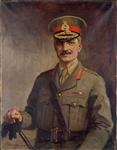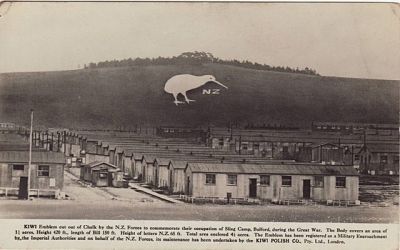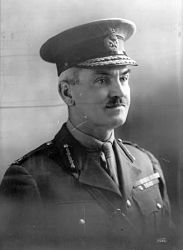WW1 Major General Sir George Spafford Richardson
George Richardson was born in Northampton, UK in 1868. He had been a master gunner who came to New Zealand in 1891 as an instructor in gunnery for the NZ Army.
In April 1907 he was commissioned as a captain in the New Zealand Militia, and became chief instructor of artillery services. It was noted in 1909 that he was ‘the hardest worked officer in the service’. He rose rapidly through the New Zealand military forces and was New Zealand’s representative on the Imperial General Staff at the War Office in London during World War 1. He saw service in Belgium, Gallipoli, France and Greece.
Richardson went to France in mid-September 1914 and became part of the division’s improvised headquarters staff during its brief, unsuccessful deployment in defence of Antwerp in early October. After narrowly avoiding being taken prisoner, he again served in France before returning to Britain in November 1914, when he was confirmed as assistant adjutant and quartermaster general. From March to December 1915 the division took part in the Gallipoli campaign. So well did he perform that he was made a CMG and promoted deputy adjutant and quartermaster of XII Corps at Salonika with the rank of brigadier general.
The New Zealand Government, meanwhile, had applied to the War Office for the return of Brigadier-General Richardson to the New Zealand Staff. Richardson was accordingly appointed General Officer in charge of the Administration of the New Zealand Expeditionary Force in the United Kingdom, a position he occupied to the end of the war, probably sacrificing his chance of the command of a division. He assumed control in London on April 2nd, 1916.
Before it had been known that troops would be needed for Gallipoli, Richmond Park, on the edge of the western suburbs of London, was suggested as New Zealand’s base camp in England, but Richardson as New Zealand’s senior officer attached to the War Office, on being consulted, recommended a locality “more distant from the attractions of the Metropolis”. The Salisbury Plains were accordingly decided upon for the establishment of Sling Camp.(1)
Richardson’s first task was to map out an organisation for future requirements. At that time Hornchurch was the sole New Zealand camp in Great Britain, accommodating both convalescents and fit men. Based on experience of the Gallipoli campaign and the Egyptian camps, when the Division transferred to France separate provision was arranged as follows for each stage: (1) for hospital cases; (2) for men in convalescent stages; (3) for men in the period between convalescence and fitness; and (4) for men sufficiently recovered to be trained for active service. Hornchurch was set aside exclusively for a convalescent hospital to which all patients leaving hospital were sent; and the reinforcements arriving, and men in the United Kingdom who had become fit, were entrained to Sling.(2)
After relinquishing his position on 10 February 1919 Richardson returned to New Zealand, where he took charge of administration at General Headquarters in Wellington with the rank of brigadier general. He chaired the Reconstruction Committee, which sought to re-establish a peacetime organisation for the defence forces, and sat on the Air Board. But, in indifferent health, he did not find peacetime soldiering satisfying. An offer to retire in 1920 was not accepted, and he remained at his post until appointed administrator of New Zealand’s mandated territory, Western Samoa, in February 1923. Shortly before taking up his duties on 19 March he was promoted to the rank of major general. (3)
He received many awards — a CMG, a CBE and CB and was knighted in 1925 (KBE).(4). He was also appointed a Chevalier of the Legion of Honour by the President of France in March 1916. This French award is uncommon to New Zealanders: fewer than 100 awards have been made, and Richardson was one of only 14 members of the New Zealand Expeditionary Force to be decorated with the Legion of Honour during the war. He was also awarded the Croix de Guerre by the King of Belgium in 1922.
He lived in Remuera at 20 Omahu Rd on the corner of Platina St, with his wife Caroline and five children. He worked assiduously for returned servicemen, especially the disabled. In May 1935 he entered local body politics as a member of the Auckland City Council; he was deputy mayor at the time of his sudden death aged 70 on 11 June 1938. Two thousand people attended the funeral service of this unpretentious man, who never forgot his humble beginnings and who throughout his military career, at least, displayed a rare ability to engender confidence among his superiors and loyalty from those serving under him.(5) He was president of the Auckland Returned Services Association and founder/patron of the Remuera Returned Soldiers Social Club in 1932.
A POET’S GRAVE Much has been written about the last resting-place of the poet Rupert Brooke, who died two days before the Gallipoli landing, on the small Greek island of Skyros, where he was serving as an officer in the Royal Naval Division, says the “New Zealand Herald.” It is not generally known, however, that the beautiful site of the grave was chosen by the late Major- General Sir George Richardson, who at that time was a lieutenant-colonel on the staff of the division. Some years ago, in an address to the boys of the Auckland Grammar School, Sir George stated that the responsibility had been his. “I selected his grave on a little knoll under an olive tree,” he said, “and there he lies peacefully today.” Evening Post, Volume CXXV, Issue 138, 14 June 1938, Page 15.


